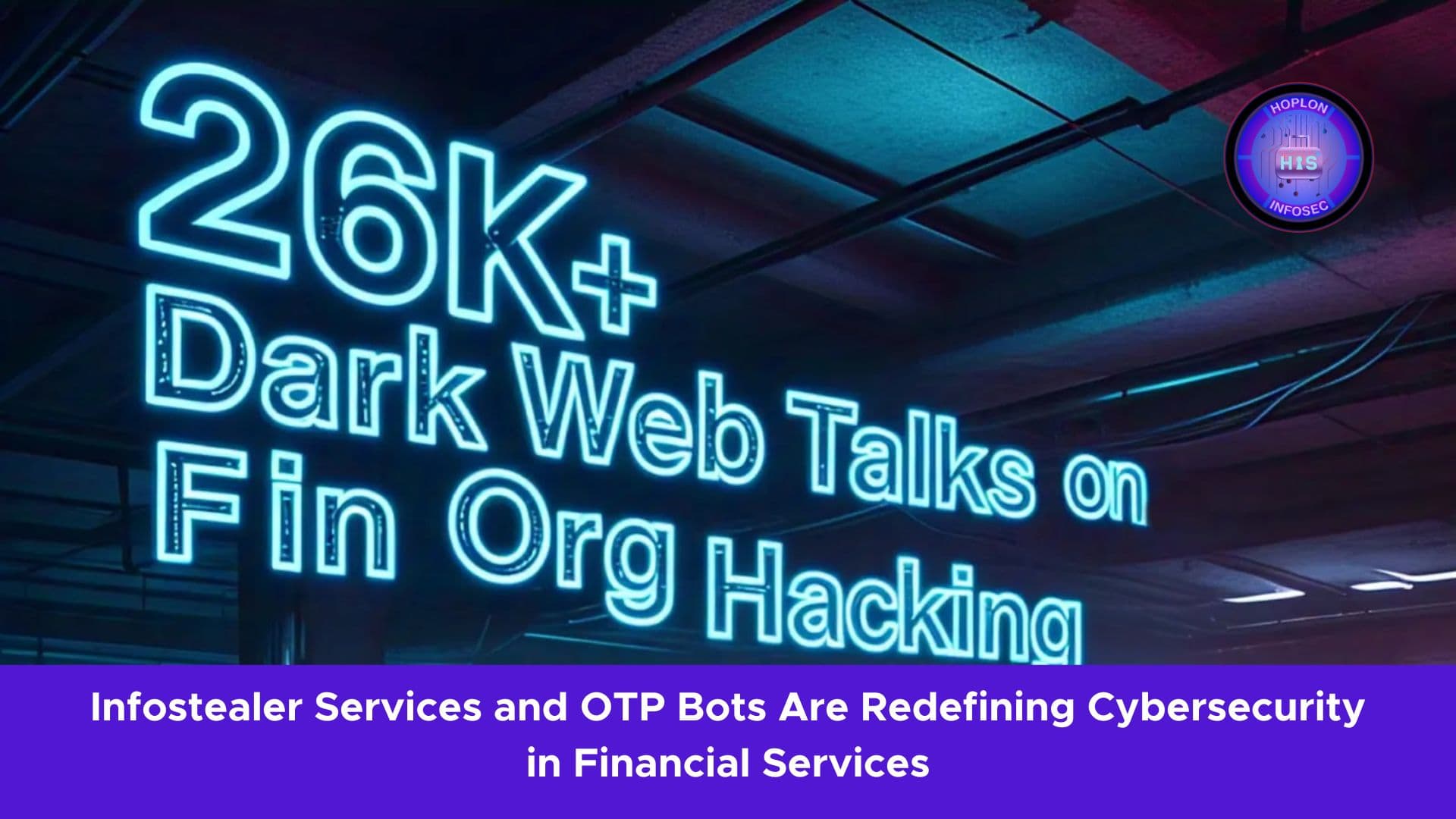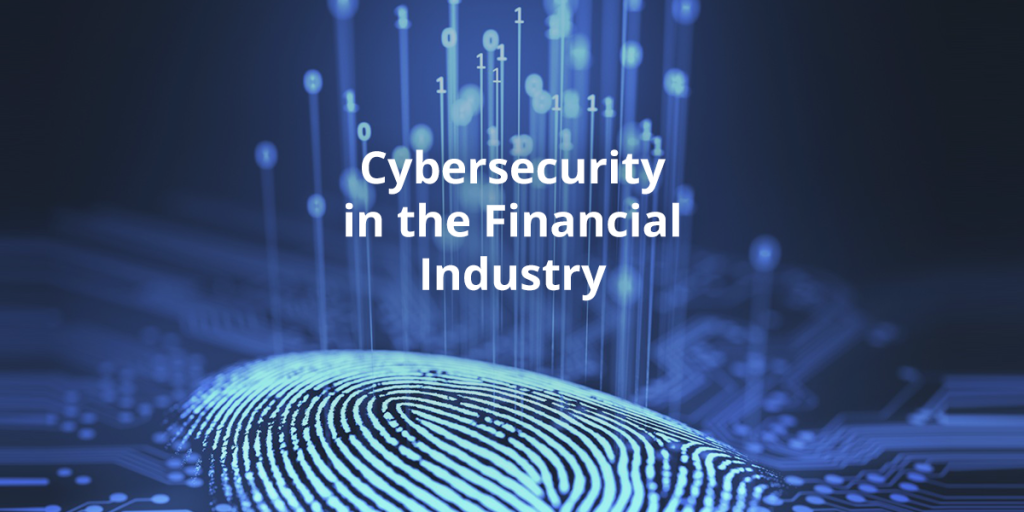How Infostealer Services and OTP Bots Are Redefining Cybersecurity in Financial Services

Hoplon InfoSec
08 Apr, 2025
The cybersecurity environment is profoundly transforming as threat actors continuously refine and develop increasingly sophisticated methods to bypass even the most robust security measures. Recent research has revealed that the financial services industry, in particular, is facing unprecedented challenges due to cybercriminals’ targeted efforts. In this comprehensive analysis, we delve into the dynamics of the deep-web underworld, explore the underground economy of info-stealer services, and examine the rise of advanced attack tools that reshape the threat landscape for financial institutions.
Deep Web Analysis: Cybersecurity in Finance

In a study conducted throughout 2024, researchers examined 46 deep-web hacker forums along with over 26,000 forum threads from various threat actor communities. This extensive investigation uncovered alarming trends that shed light on cybercriminals’ evolving tactics, techniques, and procedures. These insights are critical for understanding how attackers have adapted to new technological environments and how they now leverage decentralized platforms to coordinate and execute their malicious activities.
The Scope of the Deep-Web Research
The research methodically combed through a vast data repository on dark web forums, providing analysts with a comprehensive look into the operations of over 26,000 threat actor threads. The depth of this analysis has allowed cybersecurity experts to identify patterns and trends previously obscured by the sheer volume and complexity of the content available on these forums.
Key Findings from the Research
One of the most notable findings is the thriving underground economy built around information-stealing malware. Forums consistently discussed “infostealer-as-a-service” tools, with each platform recording an average of three to four unique daily mentions. This statistic underscores the pervasive nature of these services and highlights how cybercriminals are increasingly commoditizing tools designed to extract sensitive data from their targets.
The Underground Economy of Infostealer Services

Cybercriminals have evolved from being lone wolves to part of a sophisticated, structured underground economy. Infostealer services, in particular, have become a cornerstone of this economy. These services are now marketed with the same level of professionalism as legitimate software products, complete with enhanced user interfaces, technical support, and specialized modules tailored to the needs of specific target groups.
Detailed Look at Infostealer-as-a-Service
Infostealer-as-a-service refers to the business model where cybercriminals offer malware to extract information from compromised systems. This service model lowers the barrier of entry for less technically skilled attackers, enabling them to launch sophisticated attacks with minimal effort. The professional presentation of these tools, including user-friendly interfaces and responsive customer support, suggests that developers target amateur threat actors and well-funded advanced persistent threat (APT) groups.
Customization for Corporate Attacks
A particularly alarming trend is customising these info-stealer tools to target corporate accounts. For instance, some malware solutions now feature modules specifically designed to extract passwords from popular corporate applications such as Outlook. This deliberate tailoring indicates that threat actors focus on compromising financial institutions, where the potential payoff from a successful breach is substantially higher.
The Rise of Targeted Corporate Credential Stealers
Financial institutions have become prime targets for cybercriminals due to the immense value of their data. The research highlighted that malware developers are increasingly offering specialized functionality engineered to extract sensitive corporate credentials. These tools bypass conventional security measures and directly exploit vulnerabilities in widely used corporate software.
The Example of Mystic Stealer
One standout example mentioned in the study is Mystic Stealer. This tool is not just another generic piece of malware; it is designed with a clear strategic focus on the corporate sector. Mystic Stealer includes functionality for extracting passwords from applications integral to corporate communication and data management, such as Microsoft Outlook. This specificity reveals a calculated effort by cybercriminals to align their attack methods with the environments of their targeted victims.
Implications for Financial Organizations
The evolution of these attack tools poses significant risks for financial institutions. The highly specialized nature of the malware means that even organizations with robust cybersecurity protocols can be caught off guard. Traditional defence mechanisms are often geared toward more generalized threats, and the tailored approaches employed by modern cybercriminals require a shift in strategy. Financial organizations must now consider advanced threat intelligence and specialized defences that can detect and neutralize these bespoke attacks.
Decentralization of Cybercrime: A New Paradigm

One of the most profound shifts in cybersecurity is the decentralization of cybercrime operations. This trend is exemplified by the increasing separation between attack developers and the threat actors who deploy these tools. The deep web facilitates this division, where various forums serve as marketplaces and discussion boards for cybercriminals to exchange knowledge and resources without fear of immediate law enforcement intervention.
The Dynamics of Decentralized Cybercrime
Decentralized cybercrime means that the traditional roles within the criminal ecosystem have become blurred. Developers create sophisticated attack tools that can be used by virtually anyone with basic technical know-how, effectively democratizing the ability to launch high-stakes cyberattacks. This separation of roles makes it considerably harder for authorities to attribute cyberattacks to specific individuals or groups, as the operational responsibility is diffused across multiple entities.
Challenges for Law Enforcement
The decentralization of cybercrime presents a formidable challenge for law enforcement agencies around the globe. With the barriers between tool development and execution removed, identifying and apprehending the responsible parties requires more than technical expertise—it demands a comprehensive, coordinated approach that spans international borders. Moreover, the anonymity the deep web provides complicates efforts to trace cybercriminal activities back to their sources.
The Emergence of OTP Bot Services
Among the most significant developments noted in the 2024 research is the emergence of OTP (One-Time Password) bot services. These services are particularly concerning because they automate a critical step in bypassing two-factor authentication (2FA), a security measure many organizations rely on to protect sensitive accounts.
How OTP Bots Operate
OTP bots have emerged as a sophisticated tool in the cybercriminal arsenal. They operate primarily via platforms like Telegram, offering automated services that assist in social engineering attacks. The process begins with a credential stuffing attack, where attackers use leaked username-password combinations to attempt unauthorized access. When 2FA requirements thwart these attempts, the OTP bots come into play.
The bots are programmed to impersonate legitimate entities through pre-recorded or even AI-generated voice calls and SMS messages. By mimicking authentic communication, these bots trick victims into providing the one-time password sent to their devices. Once the code is received, attackers quickly change the account’s password and associated contact details, effectively locking out the legitimate user.
Scale and Cost of OTP Bot Services
According to forum advertisements cited in the research, at least 38 different OTP bot services are currently available on the dark web. These services are marketed at affordable prices, ranging between $10 and $50 per attack. The pricing strategy, coupled with an observed increase of 31% in mentions between 2023 and 2024, underscores the growing popularity and accessibility of these attack methods.
The Implications for Financial Institutions
The evolution of cyberattack strategies, particularly the rise of tailored infostealer tools and OTP bots, poses significant risks to financial organizations. These institutions are not only responsible for safeguarding sensitive financial data but are also under increasing pressure to maintain the trust of their clients. As cybercriminals refine their techniques, the defensive strategies employed by financial institutions must also evolve.
Increased Vulnerability and Exposure
Financial institutions are particularly vulnerable due to the sheer volume and value of the data they store. The advanced functionalities integrated into modern malware allow threat actors to bypass traditional security measures that many organizations still rely on. This increased exposure necessitates a reevaluation of existing cybersecurity frameworks to incorporate more proactive and adaptive measures.
Proactive Threat Intelligence
Financial organizations need to adopt a proactive approach to threat intelligence to combat these emerging threats. This means relying on traditional security measures and actively monitoring deep and dark web platforms for signs of impending attacks. By gathering actionable intelligence from these underground forums, organizations can better prepare for and mitigate the risks of targeted cyberattacks.
Defensive Strategies Against Modern Cyber Threats

Financial institutions must update their cybersecurity strategies in the face of these evolving threats. The following sections detail some of the most effective defensive measures that organizations can adopt to protect themselves against cybercriminals’ advanced tactics.
Enhancing Two-Factor Authentication Protocols
While two-factor authentication remains a critical layer of defence, the rise of OTP bot services necessitates improvements in this area. Financial institutions should consider implementing more robust multi-factor authentication methods beyond traditional SMS or voice call verification. Solutions such as hardware tokens or biometric verification can provide an additional layer of security that is harder for cybercriminals to replicate or bypass.
Continuous Monitoring and Threat Intelligence
A robust threat intelligence program is one of the best defences against targeted cyberattacks. Financial organizations should invest in advanced monitoring systems that continuously scan both the open web and the deep web for indicators of compromise. By analyzing data from multiple sources, security teams can detect early signs of a planned attack and take proactive measures to mitigate the threat.
Employee Training and Awareness
Many cyberattacks succeed not because of a lack of technological defences but due to human error. Regular training and awareness programs can significantly reduce the risk of social engineering attacks, including those that leverage OTP bots. Employees should be well-informed about the latest phishing techniques and the importance of verifying any requests for sensitive information, especially those that appear to come from trusted sources.
Collaboration with Cybersecurity Experts
Given the sophisticated nature of modern cyber threats, financial institutions may benefit from collaborating with cybersecurity experts and third-party vendors. These specialists can provide in-depth analysis, conduct regular security audits, and help develop strategies tailored to each organisation’s unique needs. By partnering with experts, institutions can stay ahead of cybercriminals and adapt their defences to new challenges as they arise.
The Future of Cybersecurity in Financial Services
The rapidly evolving threat landscape requires financial institutions to adapt and innovate their cybersecurity measures continually. The trends observed in 2024 indicate that cybercriminals are becoming more organized, technologically advanced, and daring in their methods. This shift will likely continue as attackers exploit emerging technologies and vulnerabilities in legacy systems.
Anticipating New Threat Vectors
As financial institutions upgrade their systems and implement more advanced security protocols, cybercriminals will likely shift their focus to new vulnerabilities. Future threats may include sophisticated attacks on blockchain technologies, exploiting vulnerabilities in emerging financial technologies, and even coordinated cyber-physical attacks that could disrupt critical infrastructure. Staying ahead of these developments requires constant vigilance and adopting cutting-edge defensive strategies.
Embracing a Culture of Cyber Resilience
Ultimately, the key to combating these evolving threats is building robust defences and fostering a culture of cyber resilience within financial institutions. This involves a holistic approach to cybersecurity that includes regular risk assessments, continuous monitoring, and the integration of threat intelligence into daily operations. Organizations that prioritize resilience are better equipped to absorb and recover from cyberattacks, minimizing the impact on their operations and reputation.
Strategic Recommendations for Financial Institutions
Financial institutions should consider several strategic recommendations to bolster their defences and safeguard their assets in light of the ongoing transformation in the cyber threat landscape.
Invest in Advanced Cybersecurity Technologies
Adopting advanced cybersecurity technologies is one of the most effective ways to combat the evolving threat landscape. Artificial intelligence (AI) and machine learning (ML) can be leveraged to analyze vast amounts of data and detect anomalies that may indicate a cyberattack. These technologies can enhance the capabilities of traditional security measures, providing an additional layer of defence against sophisticated threats.
Foster a Collaborative Security Environment
Cybersecurity is not an isolated endeavour. Financial institutions must cultivate an environment where information sharing and collaboration are prioritized. Organizations can gain valuable insights into emerging threats and share best practices for mitigating risk by working closely with industry peers, regulatory bodies, and cybersecurity experts. Collaborative efforts can lead to developing industry-wide standards that improve overall resilience against cyberattacks.
Regularly Update Security Protocols
The dynamic nature of cyber threats necessitates regular updates to security protocols and defence mechanisms. Financial institutions should establish a framework for periodic reviews of their cybersecurity strategies, ensuring they remain effective against the latest threats. This proactive approach will help organizations quickly identify and address weaknesses in their defences, reducing the likelihood of a successful cyberattack.
Prioritize Incident Response and Recovery Planning
Even the most robust cybersecurity measures cannot guarantee absolute protection. Financial institutions must, therefore, prioritize the development of comprehensive incident response and recovery plans. These plans should outline clear procedures for identifying, containing, and mitigating cyberattacks and strategies for recovering from any resulting damage. Regular drills and simulations ensure that all stakeholders are prepared to act swiftly and effectively in the event of a breach.
Conclusion: Navigating the Future of Cybersecurity
The transformation of the cybersecurity landscape, particularly in the context of financial services, presents significant challenges and opportunities. The deep web analysis of hacker forums and the alarming rise of sophisticated attack tools such as info stealers and OTP bot services underscore the urgent need for financial institutions to adopt proactive and adaptive security measures.
As cybercriminals continue to innovate and decentralize their operations, organizations must shift from a reactive approach to one that emphasizes continuous threat intelligence, advanced technological defences, and robust incident response strategies. Embracing a culture of cyber resilience and fostering collaborative security efforts across the industry will be essential for navigating the complex and rapidly evolving world of cybersecurity.
Sources: Imperva, Cybersecurity News
Share this :